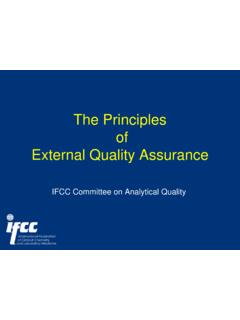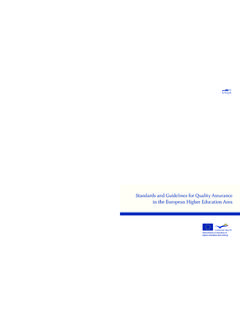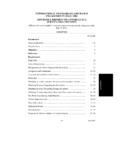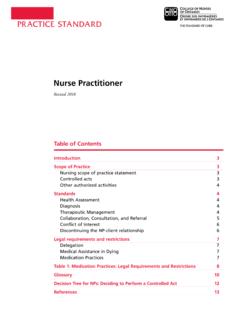Transcription of Quality assurance of pharmaceuticals - who.int
1 Quality assurance ofpharmaceuticalsA compendium of guidelines and related materialsVolume 2, 2nd updated editionGood manufacturing practices and inspectionQAPPR 12/16/06 12:10 PM Page iWHO Library Cataloguing-in-Publication DataQuality assurance of pharmaceuticals : a compendium of guidelines and related 2, Good manufacturing practices and inspection. and narcotic control standards industry preparations standards products control Health : Good manufacturing practices and inspectionISBN 92 4 154708 1(NLM classification: QV 33)ISBN 978 92 4 154708 6 World Health Organization 2007 All rights reserved. Publications of the World Health Organization can be obtained fromWHO Press, World Health Organization, 20 Avenue Appia, 1211 Geneva 27, Switzerland(tel.: +41 22 791 3264; fax: +41 22 791 4857; e-mail: Requests forpermission to reproduce or translate WHO publications whether for sale or for noncom-mercial distribution should be addressed to WHO Press, at the above address (fax: +4122 791 4806; e-mail: designations employed and the presentation of the material in this publication do notimply the expression of any opinion whatsoever on the part of the World Health Organiza-tion concerning the legal status of any country, territory, city or area or of its authorities, orconcerning the delimitation of its frontiers or boundaries.))
2 Dotted lines on maps representapproximate border lines for which there may not yet be full mention of specific companies or of certain manufacturers products does not implythat they are endorsed or recommended by the World Health Organization in preference toothers of a similar nature that are not mentioned. Errors and omissions excepted, the namesof proprietary products are distinguished by initial capital reasonable precautions have been taken by the World Health Organization to verify theinformation contained in this publication. However, the published material is being dis-tributed without warranty of any kind, either expressed or implied. The responsibility for theinterpretation and use of the material lies with the reader. In no event shall the World HealthOrganization be liable for damages arising from its in IndiaQAPPR 12/16/06 12:10 PM Page iiContentsiiiIntroduction11.
3 WHO good manufacturing practices: main principles forpharmaceutical products7 Quality management in the drug industry: philosophy and essential elements (update on sampling) (new)7 Heating Ventilation and air-conditioning systems for non-sterile pharmaceutical dosage forms (new)58 Validation (new)101 Water for pharmaceutical use (new)1702. WHO good manufacturing practices: starting materials188 Active pharmaceutical ingredients (bulk drug substances)188 Pharmaceutical excipients1963. WHO good manufacturing practices: specific pharmaceutical products215 Sterile pharmaceutical products215 Biological products232 Investigational pharmaceutical products for clinical trials in humans242 The manufacture of herbal medicines (updated)254 Radiopharmaceutical products2764. Inspection285 Pre-approval inspections285 Inspection of pharmaceutical manufacturers291 Inspection of drug distribution channels303 Quality systems requirements for national good manufacturing practice inspectorates322 Guidance on good manufacturing practices: inspection report338 Model certificate of good manufacturing practices347 QAPPR 12/16/06 12:10 PM Page iii5.
4 Hazard and risk analysis in pharmaceutical products346 Application of hazard analysis and critical control point (HACCP) methodology to pharmaceuticals3466. Sampling operations(new)359 Sampling of pharmaceutical products and related materials (new)359 Index389 Quality assurance OF PHARMACEUTICALSivQAPPR 12/16/06 12:10 PM Page iv1 IntroductionThe Quality of pharmaceuticals has been a concern of the World Health Organization (WHO) since its inception. The setting of global standards isrequested in Article 2 of the WHO Constitution, which cites as one of the Organization s functions that it should develop, establish and promote inter-national standards with respect to food, biological, pharmaceutical and similarproducts. Every government allocates a substantial proportion of its total healthbudget to medicines. This proportion tends to be greatest in developing countries, where it may exceed 40%.
5 Without assurance that these medicines are relevant to priority health needsand that they meet acceptable standards of Quality , safety and efficacy, any healthservice is evidently compromised. In developing countries considerable admin-istrative and technical effort is directed to ensuring that patients receive effectivemedicines of good Quality . It is crucial to the objective of health for all that a reli-able system of medicines control be brought within the reach of every supply of essential medicines of good Quality was identified as one ofthe prerequisites for the delivery of health care at the International Conferenceon Primary Health Care in Alma-Ata in 1978. Similarly, the Conference ofExperts on the Rational Use of Drugs, held in Nairobi in 1985, and WHO sRevised Drug Strategy, adopted by the World Health Assembly in May 1986,identified the effective functioning of national drug regulation and controlsystems as the only means to assure safety and Quality of medicines.
6 Yet theWorld Health Assembly continues to express great concern about the Quality ,safety and efficacy of medicines, particularly those products or active pharma-ceutical substances imported into, or produced in, developing countries. Inrecent years counterfeit products have infiltrated certain markets in disquietingproportions. Since the founding of WHO, the World Health Assembly hasadopted many resolutions requesting the Organization to develop internationalstandards, recommendations and instruments to assure the Quality of medicines,whether produced and traded nationally or response to these resolutions, the WHO Expert Committee on Specifications for Pharmaceutical Preparations, which was originally created toprepare The International Pharmacopoeia, has made numerous recommenda-tions relevant to Quality assurance and control. Most of these recommendations,QAPIN 12/16/06 12:17 PM Page 1even though they were made several years ago, are still valid.
7 Thus far, however,most have been available only as separate sets of recommendations containedin annexes to various WHO Technical Reports. The recommendations are essen-tial to all concerned with the Quality assurance of medicines, but separate publications over a period of years has made it difficult to recognize them ascomplementary parts of a comprehensive system of Quality provide easy access to this information, the appropriate annexes andupdates are reproduced in the volumes of this publication. They are supple-mented with other material relevant to the Quality assurance of pharmaceuti-cals, some already issued in the form of WHO documents. The information ispresented in logical sequence as a series of administrative instruments and tech-nical elements of an overall Quality assurance system. Readers should bear inmind that, in certain previously published texts, reference is made to WHOguidelines and other documents that have since been updated.
8 Some of theseupdated texts are themselves included in the 1 of Quality assurance of pharmaceuticals : a compendium of guide-lines and related materialswas published by WHO in 1997. Material relating tonational drug regulations, product assessment and registration, The InternationalPharmacopoeiaand related activities, Quality control laboratories, internationaltrade in pharmaceuticals and their distribution, counterfeit products, basic testsfor pharmaceutical products and training of technical personnel is collected andreproduced in Volume 1. Volume 2, first published by WHO in 1999, repro-duces guidelines related to good manufacturing practices (GMP) and to theinspection of pharmaceutical manufacturers and drug distribution volume was updated in 2004, and the current version constitutes thesecond updated edition of Volume 2 including new texts and revisions adoptedto date as WHO for manufacturers and at national level, GMP are an important partof a comprehensive system of Quality assurance .
9 They also represent the tech-nical standard upon which is based the WHO Certification Scheme on theQuality of Pharmaceutical Products Moving in International Commerce. Thefirst GMP text published by WHO was developed during 1967 69 uponrequest by WHO s Member States and was revised in 1975. In the 1980s andearly 1990s, several national and regional drug regulatory authorities issued orrevised guidelines reflecting the ongoing elaboration of the concept of GMP. Inaddition, the WHO Certification Scheme on the Quality of PharmaceuticalProducts Moving in International Commerce was extended in 1988. Together,these developments necessitated an update of the existing guidelines on GMPpublished by and expanded GMP guidelines were prepared during 1989 90,approved by the WHO Expert Committee on Specifications for Pharmaceuti-cal Preparations in late 1990 and subsequently published by WHO.
10 At thattime, Part One of these revised and expanded guidelines set out the philosophyand essential elements of GMP; Part Two dealt with good practices in produc- Quality assurance OF PHARMACEUTICALS2 QAPIN 12/16/06 12:17 PM Page 2tion and Quality control. These two parts together represented the core of theGMP guidelines published by provisions were and still are fully consonant with those of other inter-nationally recognized texts on GMP. GMP guidelines published by WHO areto be regarded as advisory in nature and may need to be adapted to addressspecific conditions in individual countries. However, if any departures from recommended practices are introduced, the equivalence of such alternativeapproaches should be 1996, GMP guidelines were published by WHO for the validation ofmanufacturing processes. These guidelines were prepared to explain andpromote the concept of validation embedded in the core GMP texts, and toassist in establishing priorities and selecting approaches when a validation pro-gramme is being developed.
















